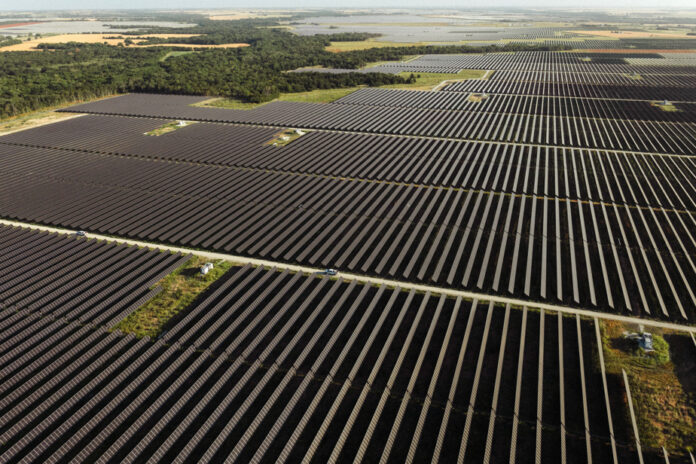The United States has embarked on the biggest industrial policy offensive in generations, promising tax breaks, subsidies and other financial incentives to attract factories making solar panels, semiconductors and electric vehicles.
This spending is intended to boost the domestic market for crucial products, but it has repercussions far beyond the United States. They are pushing governments in Europe and East Asia to try to follow suit with their own programs, sparking what some call a global race for subsidies.
Some governments, particularly in Europe, have accused the United States of protectionism and spent months complaining about its policies to the Biden administration. Governments in the European Union, the United Kingdom and other countries are considering how to counter U.S. policies by offering their own incentives to attract investment and prevent their companies from relocating to the United States.
“I think we all deny that there is a subsidy race, but to some extent that is what is happening,” said Markus Beyrer, director general of BusinessEurope, Europe’s largest business association. .
The United States is deploying nearly $400 billion in spending and tax credits to support its domestic clean energy industry under the Inflation Reduction Act of 2022. Another $280 billion dollars is intended for semiconductor manufacturing and research facilities, as well as broader technology research.
According to the Biden administration, the entire program will unlock $3.5 trillion in public capital and private investment over the next decade. It is both a response to the considerable subsidies offered by the governments of China and East Asia, and an attempt to rebuild an American industrial sector hollowed out by decades of relocations.
The administration says these investments will make the United States better equipped to deal with climate change and make it less dependent on potentially risky supply chains that run through China.
But the spending has raised concerns about using public funds at the expense of other priorities and piling on countries’ debt at a time when high interest rates make borrowing riskier and more expensive.
Gita Gopinath, first deputy managing director of the International Monetary Fund, admitted in an October interview that the spending race was “concerning.”
Ms. Gopinath cited statistics showing that every time the United States, the European Union or China puts in place subsidies or tariffs, there is a good chance that one of the other two will respond with its own subsidies or customs duties in the following year.
Spending competition also strains alliances by giving companies that make popular products such as batteries, hydrogen and semiconductors the opportunity to “shop around,” i.e. say playing governments against each other trying to find the most welcoming place for their technologies.
Freyr Battery, a European-founded company that develops lithium-ion batteries for cars, boats and storage systems, was about to build a factory in Norway when its executives learned that the Energy Reduction Act inflation was being developed. In response to this law, the company moved its production to a factory in Georgia.
“We think this is a really ingenious piece of modern industrial policy and, therefore, we have changed our tune,” said Birger Steen, CEO of Freyr, in an interview. “The surge will be in the United States, and this is because of the Inflation Reduction Act. »
Steen said the company was keeping the Norwegian plant ready for a “hot start,” meaning production could increase there if local policies became more favorable. The company is talking to policymakers about how they can compete with the United States, he added.
Some countries benefit directly from U.S. spending, including Canada, which enjoys some of the benefits of the Clean Energy Act and has mining operations that the United States lacks.
Killian Charles, CEO of Brunswick Exploration in Montreal, said in an interview that the Canadian lithium industry stands to benefit from relocating battery manufacturing to the United States and finding nearby sources of raw materials. .
But in most cases, competition appears to be zero-sum.
David Scaysbrook, managing partner of Quinbrook Infrastructure Partners Group, which has helped finance some of the largest solar and battery projects in the United States, argued that the U.S. Clean Energy Act is the most influential law introduced by one country and that other governments were not able to replicate the “magnitude” of this law.
The United States has sought to assuage some of its allies’ concerns by signing new trade agreements allowing its foreign partners to enjoy some of the benefits of the Clean Energy Act. In March, the United States signed a minerals deal with Japan that will allow Japanese facilities to supply minerals for electric vehicles that qualify for U.S. tax credits. Since last year, American authorities have been negotiating a similar agreement with Europe.
However, at a meeting in October, the United States and Europe clashed over a U.S. proposal to allow labor inspections at mines and mineral-producing facilities outside the United States. and Europe. Officials continue to work toward reaching a deal in the coming weeks, but in the meantime, the lack of an agreement has further clouded relations between the United States and the European Union.
Biden administration officials continued to defend their approach, saying the Inflation Reduction Act did not mark a turn toward U.S. protectionism and that climate spending was absolutely necessary. Even with such significant investments, the United States risks failing to meet international goals in the fight against global warming.















